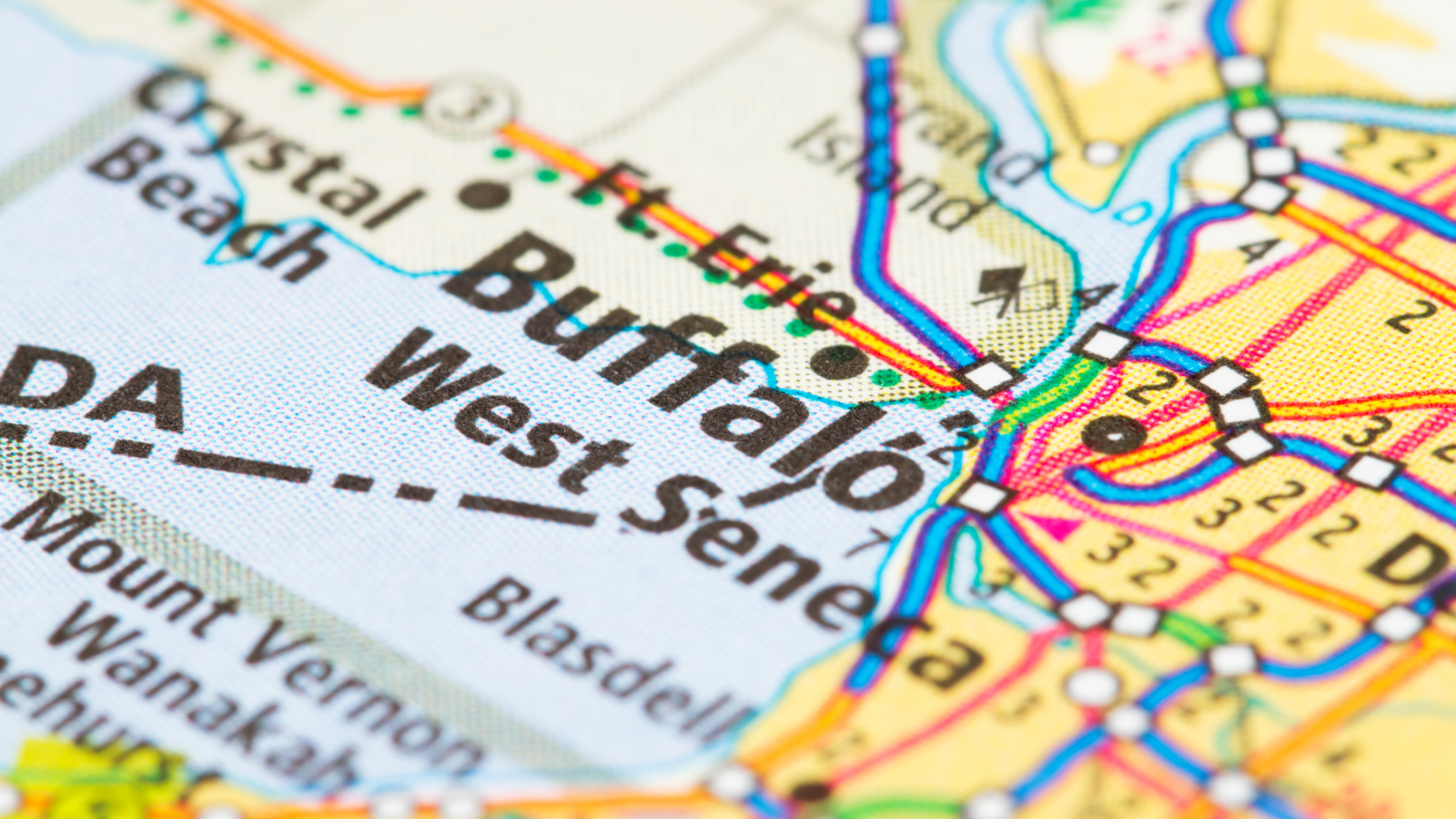We're giving some #BuffaLove to Buffalo.
This week, we’re headed back to the Empire State to visit the City of Good Neighbors, the City of Lights, the City of Trees, the Nickel City, or the City of No Illusions.
Key takeaways:
- At just over 16%, Buffalo’s median gross rent as a fraction of median income makes the city very affordable
- Downtown’s population has expanded by more than 248% since 2000
- Home prices are up 23% year-over-year, which could increase demand for multifamily housing
The City of Lights
Buffalo, the city, got its start as a village along the banks of Buffalo, the creek — a tributary of the Buffalo River. Former Revolutionary soldier Captain William Johnston was given the land by the Seneca as a reward for his work as an interpreter, and the town became a popular destination for settlers. In 1832, the city was incorporated; serving as the terminus of the Erie canal, its population exploded by the mid-1800s as it became a trade and logistics hotspot — one of the most important ports between the Great Lakes and the Atlantic.
When rail travel began to encroach on steamboats’ supremacy, Buffalo protected its status as a hub by becoming the second-largest rail hub in the country (after Chicago). Buffalo’s location and easy access to transportation enticed numerous immigrants. Get this: in 1885, nearly two-thirds of the city’s population was foreign-born. The population explosion was accompanied by a shift into manufacturing, predominated by steel. In the early 20th century, despite losing some manufacturing clout to cities like Detroit and Pittsburgh (no hard feelings, okay?), Buffalo acquired renown, and its “City of Lights” nickname, when the hydroelectric power generated by Niagara Falls facilitated the installation of some of the first electric street lamps on the city’s characteristic radial streets. However, as has been the case with several of the cities we’ve written about in this series, eventual deindustrialization — and, in Buffalo’s case, the opening of the St. Lawrence Seaway — motivated the city to diversify and reinvent its economy.
Thankfully, #InTheBuf (the local tourism hashtag), economic reinvention also brought prosperity, driving the city forward into the 21st century as an economically-diverse, affordable metro. Today, Buffalo is the second-largest city in New York, boasting a diverse economy anchored by logistics, trade, healthcare, education, life sciences, banking, and some manufacturing. Some of the city’s largest employers are M&T Bank, Kaleida Health, the State of New York, and Wegmans, and the greater Buffalo area is home to nine colleges and universities, including SUNY Buffalo.
The city that brought the world what is objectively the greatest game-day appetizer ever to be deep-fried and coated in hot sauce (and also, somewhat less importantly, two US presidents) also features a housing market that offers investors real opportunity.
Opportunities
Diverse, Resilient Economy
Like we’ve said time and again, economic diversification can afford a city strong resilience in the face of recessionary environments. In particular, sectors like healthcare and education (if you’ve been reading our blogs for a while, you knew we had to say “Meds and Eds” somewhere in here, right?) that benefit from consistent demand can anchor an economy through dry spouts, and drive growth. One data point: although some industry job availability has been declining in recent years, Buffalo’s employment has actually expanded — largely because of Meds and Eds.
Logistics and manufacturing still employ significant portions of the city’s workforce, and while the city has yet to fully recover from the onset of the COVID-19 pandemic, the comparative durability of those sectors has helped offset unsurprising losses.

Employment in the Buffalo area hasn’t recovered as quickly as in some other metros, but that’s due in large part to the city’s large hospitality and leisure sector. With Niagara Falls close by, two casinos, five Frank Lloyd Wright houses in town, and the aforementioned saucy chicken pieces, it’s no surprise that Buffalo’s tourism industry has historically performed well. Tourism, along with healthcare, and education, were Buffalo’s fastest-growing sectors behind an impressive recovery from the 2008 crisis. It’s also no surprise that leisure and hospitality has taken a beating over the past year. However, we’d expect to see jobs numbers rise over the summer as vaccination continues and Americans decide it’s really time for a long vacation and a professional haircut.
On the macro level, Buffalo’s economic profile is comparable to Rochester’s, according to 2019 data from the New York Fed:

Steady job growth, a healthy GDP, and an affordable housing market have promoted economic expansion, enabled public-private cooperative projects, and brought business into town. Legacy employers like Ford and GM still maintain operations in Buffalo, but the city is also exposed to tech industry upside. Notably, Tesla located Gigafactory 2 in the metro, and this is projected to create at least 5,000 jobs over the next decade.
Affordable, In-Demand Housing
Buffalo’s economic performance over the past decade is encouraging, as it diversifies into industries benefiting from resilient demand. But Buffalo’s real powerhouse of value is its housing market, which is ranked among the most affordable of any major US city. Some quick stats:
- In 2019, according to the Census Bureau’s American Community Survey, Buffalo’s rent as a fraction of income was only 16.53%, compared to 21.78% statewide and 20.03% nationwide.
- In the same survey, rental vacancy was 3.74%.
- In 2019, Buffalo’s price-to-rent ratio was 10.66, compared to a national average of 18.09 for the country’s 50 largest cities..
- Total living cost in the city is 4% lower than the national average.
Buffalo’s relatively affordable single-family market encourages a larger homeowner fraction than some of its neighbors (looking at you, NYC), but the multifamily space nonetheless attracts more than a third of the city’s households — and it isn’t difficult to see why.

We’ve argued before that, while still very important, absolute affordability is less important than comparative affordability, and Buffalo’s housing costs compared to the New York state median are staggeringly low. As NYC’s professionals continue to leave the city in search of backyards and home offices, metros like Buffalo and Rochester that keep families in-state at dramatically lower costs could continue to pick up steam.
Although the (currently) fairly-affordable single-family market could absorb some of the heat, home prices trended up 23% year-over-year. Given how low Buffalo’s rental vacancy is already, supply-side shortages could come into view. While these forces could complicate entry for interested investors, those already holding property in Buffalo could be in a position to earn strong returns. A few scenarios could play out:
- Multifamily investors can capture value from a hot market by increasing rents. While affordability is a draw, Buffalo rents could absorb a meaningful increase (say, 2% of tenant income per year) and still remain significantly more affordable than national averages, much less NYC.
- Buildings situated downtown, where residents ballooned 248% over the past 20 years, could see appreciation.
- As revitalization efforts continue, apartments in Buffalo proper could see increased demand, while suburban apartments could see slower growth.
Risks
The housing market is basically a platter of buffalo wings
It’s hot. Vacancy is low, demand is rising, and median rental prices have yet to adjust to either median income or rental prices in surrounding metros. Meanwhile, the single-family market continues to see rising demand, somewhat because of the COVID-19 pandemic.
For investors who already own property in Buffalo, the outlook is good: rising rents, reliable demand, and appreciation at sale.
For investors looking to buy property in Buffalo, a hot market could mean cap rate compression and bidding wars that complicate the acquisition process and raise the bar for viable returns. Riding the tide of rising incomes and rents could help offset lofty valuations and elevated acquisitions expenses, but a deep buying market that potentially overvalues property is still a risk to be aware of.
Unique economy, asymmetrical risks
Buffalo’s growing tourism industry brings in billions of dollars every year during normal circumstances. It’s become trite to remark that no one expected a global pandemic to emerge in early 2020, but the fact is that one of Buffalo’s largest sectors — by both revenue and employment — capsized virtually overnight when the COVID-19 pandemic struck.
That doesn’t usually happen, and Buffalo’s unique geography and cultural appeal will probably bolster the flagging leisure and hospitality sector as the nationwide vaccination campaign continues and America returns to normal — we’re definitely ready for a vacation ourselves. But, as of February 2021, employment in Buffalo’s leisure and hospitality sector was still down more than 25%. Time will tell, but investors looking at Buffalo in mid-2021 can’t be assured that the tourism industry will return to its former glory.
Poverty rate
30.1% of Buffalo’s residents live below the poverty line. That’s 5% lower than Detroit’s, but still nearly triple the national rate — and the rate hasn’t moved much over the last decade, suggesting that wealth increases have largely been isolated to the middle-to-upper-classes.
While housing is still relatively affordable, both as a fraction of income and in comparison to surrounding metros, economic growth in the city has done relatively little for the bottom 25% of the population, who still often struggle to pay rents.
For investors, this raises the risk of costly eviction proceedings. In Buffalo, as many as 13% of renting households are evicted annually.
On the other hand, affordable housing for the lowest income people in the area can be scarce in Buffalo, with waiting lists sometimes stretching years into the future. For investors interested in increasing affordable housing options, Buffalo could offer opportunity.
Population loss
New York State currently leads the country in out-migration. While Buffalo hasn’t witnessed losses on the scale of NYC, its population has contracted by more than 2% over the last decade. For some investors, this trend may raise questions about vacancy, and the Buffalo rental market’s long-term affordability.
However, population change isn’t everything. Like we pointed out earlier, demand is skyrocketing in the downtown region as job opportunities and urbanization lure tenants to a handful of hot city blocks. In those areas, vacancy is low and demand is rising — all but ensuring investors can secure returns.
In general, Buffalo’s population decline is less relevant than the overall need for particular kinds of properties; in both the affordable housing space and the luxury downtown space, rental demand is still high.
Concluding Thoughts
While interested investors will have to contend with risks, Buffalo’s value proposition is impressive. Very (currently) affordable housing plus low vacancy plus increasing demand puts investors in a strong position to produce returns.
If in-state residents looking to lower their living costs choose Buffalo, the business and tech industries continue to expand, and the metro’s sizable tourism industry regains momentum, Buffalo may also be exposed to upside potential.

